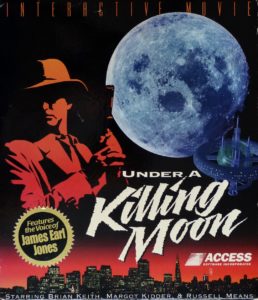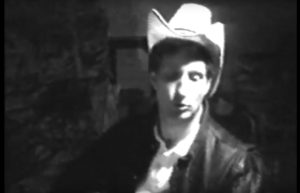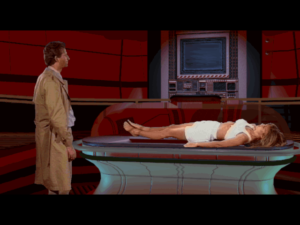We couldn’t believe one CD could be filled up so quickly.
— Aaron Conners
Bountiful, Utah, is the second city of the Church of Jesus Christ of Latter-Day Saints. Legend has it that its patriarch, a herdsman named Perrigrine Sessions, exclaimed, “Here at last is paradise on earth!” on the day in 1847 when he first looked down upon the lush valley where the city stands today.
Like so many Mormon communities, Bountiful seems frozen in time, or rather out of time, a vision of a bucolic 1950s small-town America that barely ever existed in reality. The city’s newsletters have a weirdly anachronistic tone, regardless of their cover date. An issue from 1993 notes with alarm that a gang (!) has been formed, whilst going on to add a little reluctantly that it doesn’t appear to have committed any actual crimes yet. (“We hope that gang activity can be stopped before it takes a foothold.”) The same issue looks forward to “patriotic Americana” in the city park with “Utah Voices and the 23rd Army Band.” Somewhere in Bountiful, one senses, a middle-aged matron is still shaking her head disapprovingly over Elvis Presley and those gyrating hips of his — “and yet he seems such a nice, well-spoken young man otherwise…”
She was doubtless doing the same in the late 1960s, when a handful of Bountiful kids started to shoot their own movies on the new Kodak film format of Super 8. Chris Jones, Doug Vandegrift, and a collection of assorted siblings, cousins, and friends spoofed the things they were watching at the local cinema and on television: Batman, Tarzan, Mission: Impossible. Judging from the few fragments of their movies that have survived, they were hopelessly square — it’s hard to believe that they’re contemporaneous with the likes of Woodstock and Easy Rider — but also clever and endearingly cheeky. Typical Bountiful art, in other words.
Inspired by these experiments, Vandegrift went off to university to study acting, while Jones, being of a more practical bent, went out for finance. After university, Vandegrift switched from acting for a camera to drawing for one, landing a job with Hanna-Barbera illustrating Saturday-morning cartoons. He parlayed that gig into an impressive career; he won an Emmy Award in 1988 for his work on Muppet Babies. Meanwhile Jones wound up an accountant at an engineering firm in Salt Lake City.
Jones had a friend named Bruce Carver, who in 1982 bought one of the first Commodore 64s ever sold in Utah. He discovered a latent genius in himself as soon as he began to program it, and founded Access Software to publish his work. Jones initially joined the venture, whose offices would move back and forth between Salt Lake City and Bountiful as it grew, as its part-time sales representative and accountant, but he quickly grew fascinated with the creative potential of the new medium his friend was exploring. Thus he sketched out the scenario for a multi-part action game called Beach-Head, which Carver then proceeded to implement in code. Like virtually everything else Jones would ever do on a computer, this first game was inspired by his love of movies — in this case, by rah-rah World War II movies starring John Wayne and similarly lantern-jawed leading men. Thanks to Carver’s programming chops and Jones’s instinct for cinematic drama, Beach-Head became the breakout hit that put Access on the map upon its release in October of 1983. Raid Over Moscow and Beach-Head II, more games in the same style, did almost as well in 1984 and 1985.
After that, however, Bruce Carver stumbled upon the subject matter that would sustain Access for almost two decades. He and his brother Roger Carver made a golf game called Leader Board in 1986, which begot World Class Leader Board the following year, which in turn begot the long-running Links series in 1990. These games were very, very good for Access in general, but something of a mixed blessing for Chris Jones, who was now working full-time for the company, keeping track of all the money they were bringing in. The reality was that he just didn’t have much to contribute creatively to a golf simulation.
So, he decided to get the old gang back together and make another movie instead. Vandegrift had recently returned to Bountiful to take a job as Access’s art director, and was more than up for Jones’s plan. The two had dreams of showing at Sundance as they wrote a script that combined The Maltese Falcon with Close Encounters of the Third Kind. Jones took the starring role of a private detective born in the wrong time, who channeled not only Humphrey Bogart but also Roy Rogers, what with his penchant for yodeling cowboy tunes. The detective-cum-cowboy’s name was Tex Murphy.
But the film went disastrously wrong. All Sundance ambitions went out the window when someone stole the gang’s brand-new 16-millimeter camera, forcing them to switch back to Super 8, then to videotape because, hey, film gets expensive. Most of the soundtrack got lost, forcing everyone to re-dub their lines. The project devolved into Plan Ten from Outer Space, a ludicrous farce whose only obvious advantage over the awful Ed Wood film it purports to spoof is the fact that it knows how terrible it is. And yet it’s also really, genuinely funny, even when it’s abundantly clear that its creators have no idea what they’re doing. It’s smart in its amateurishness, bursting with a joie de vivre that just can’t be faked. In this, it has much in common with what came later from many of the same creators.
Disappointed to have made a film that could only be shown to family and friends, however much fun he’d had with it, Jones proposed adapting it into a computer game built out of spare parts that happened to be lying around the Access offices. Bruce Carver had been blending real-world photography with computer graphics since making the first Leader Board a couple of years before; for that game and its sequel, he had captured Roger Carver swinging a golf club on videotape and imported selected frames using primitive digitization technology, all in order to give a smooth, realistic depiction of the subject. And Access also had a vaguely Starglider-like outer-space shoot-em-up called Echelon on the shelf, which Bruce Carver had worked very hard on but which had given a poor return on his investment; the game had never sold very well. Now, he agreed to let Jones make an adventure game relying heavily on digitized images, its puzzle-solving scenes glued together by a flight-simulator game that re-purposed some of the old Echelon code. It would move Tex Murphy into the dystopian world of the year 2033, largely dropping his Roy Rogers persona but doubling down on Humphrey Bogart. Cheerfully appropriating the name of a classic Martin Scorsese film without giving it a second thought, Jones dubbed the game Mean Streets.
Today Jones regards Mean Streets, like Plan Ten from Outer Space, as non-canonical, a piece of Tex Murphy juvenilia, and that’s probably a fair assessment. But, as with the movie, auguries of what came later are all over this work. Mean Streets mixes wildly disparate interfaces and modes of play with giddy abandon: the flight simulator you use to fly Tex’s speeder from place to place, the side-scrolling shoot-em-up you get dumped into when negotiations go south, the adventure game of searching locations for clues, the menu-driven conversations with some two dozen witnesses and suspects in the crime you’re trying to solve. It stitches this crazy quilt together using cutting-edge technical tricks from its time: all of the characters you meet are presented as 256-color digitized photographs — Jones once again plays Tex — and snippets of digitized speech pop up here and there, thanks to another of Bruce Carver’s brilliant innovations, a technology called Real Sound that let a game play back just what the name would imply on an MS-DOS computer without an add-on sound card.
Such an overweening focus on trendy gimmicks seldom yields a classic game; no surprise, then, that Mean Streets doesn’t quite earn that label. And yet Jones, working with Doug Vandegrift as art director, managed to bring it closer to that status than one might expect, thanks to yet another quality that would show up again in the future: a thoroughgoing willingness among the developers to put themselves in the player’s shoes, to try to play with her rather than against her. In Mean Streets, you can fly your speeder manually everywhere if that’s what you enjoy, or you can turn on the autopilot and zip to your destination; you can screw around in the desert outside of town shooting bounty hunters all day, or you can diligently pursue the resolution of the mystery with the help of the notepad thoughtfully included in the box. Even when it comes to the gimmicks, one never gets the impression the developers were thinking, “Including real pictures in our game will surely make us market leaders and sell a million copies!” No, it’s rather, “Gee, real pictures… in a game! How cool is that? Let’s do it!”
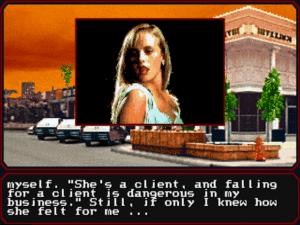
The “cast” of Mean Streets consisted of colleagues and friends, along with a smattering of fashion models recruited from a local agency. This character, whose name is Sylvia Linsky, would later show up in Under a Killing Moon as Tex Murphy’s ex-wife. (The course of love is never straight and true…) Even these few lines of text are enough to demonstrate the awkward writing that dogged these early games, which would be remedied only by the arrival of Aaron Conners on the scene. “If only I knew how she felt for me…” About me, maybe?
Released in late 1989, Mean Streets sold well enough to justify continuing with adventure games as a sideline to Access’s main business of golf simulations. In fact, Jones, Vandegrift and their colleagues made no fewer than three more games in the same general style as Mean Streets, minus only the flight simulator and shoot-em-up sequences, which most players of the first game had agreed were a bridge too far. The games in question were called Countdown, Martian Memorandum, and Amazon: Guardians of Eden, of which trio only the middle entry starred Tex Murphy. Then, the era of juvenilia ended as Jones and company took things to another level entirely.
Access was flying higher than ever at the time, but the reasons for their success still had much more to do with their golf games than their adventure games. In 1992, the year that Chris Jones made Amazon, Bruce Carver made Links 386 Pro, the first major game of any stripe to require a high-resolution “Super VGA” graphics card. It became a smashing hit, selling to many gamers who couldn’t care less about the sport of golf but just wanted to take in the mouth-watering details of the game’s meticulously recreated real-world courses. With Access thus flusher than ever with cash, Jones sought and won permission to, as he put it, “make the Links 386 of adventure games,” employing not only the new technology of SVGA but also CD-ROM. It was a tremendous gamble — the industry had been waiting in vain for CD-ROM to break through for literally years already — but the money flowing in from Links put Access in a position where they could afford to take such risks.
Although Doug Vandegrift had provided welcome assistance, all of Access’s adventure games to date had been Chris Jones’s babies at bottom, a fact that was perhaps not completely to their benefit. Jones was many things, but he wasn’t a terribly accomplished writer, and it often showed. Luckily, Access had recently hired as a technical writer a fellow named Aaron Conners, holder of a degree in English literature from the University of Utah. He’d become chummy with Jones when he was assigned to write hints for Amazon. Now, Jones asked him to write a full-length script for a third Tex Murphy game that would pull out all the stops.
It was the best move he ever made; Conners brought a whole new dimension to the character, adding not just more layers of humor but a degree of pathos as well. Conners:
He’s a man out of time, which works well because we can put him in an environment that none of us are familiar with, and he doesn’t seem to be familiar with it either. So, we can relate to him.
At the same time, he’s got the sensibilities of the 1940s, which is nostalgic to us. I think it ties in really well together, but it’s inherently humorous because he’s constantly out of place, no matter where he goes. He’s a [private detective], and he doesn’t really have any peers [in the future]. When he goes to the people who hire him, they’re generally higher class and think he’s scum. And yet he thinks that everyone at his level or lower is scum.
Tex’s basic attitude reminds me of the George Carlin line: “When you’re out driving, anyone driving slower than you is an idiot, and anyone driving faster than you is a maniac.” That’s kind of the way Tex is. He doesn’t seem to fit in with anyone. Tex has an inherent dislike of people who are born privileged. So he just has to poke them all the time. That’s how I see Tex’s character, fueled by this natural irreverence.
In November of 1992, three months after being given the assignment, Conners handed Jones the story for Under a Killing Moon, then stepped up to join him as co-designer. The two have been professionally inseparable ever since.
The story takes place in the San Francisco of 2042, ten years after Mean Streets. The people of the city, who live out their lives in a Blade Runner-esque nocturnal setting, have been segregated into “norms” who don’t evince radiation-induced mutations and “mutes” who do. Tex himself is a norm, but he feels more comfortable among the mutes who inhabit the ghettos of the city. In the course of the game, his investigation of a petty robbery at a local pawnshop puts him on the trail of a worldwide eugenicist conspiracy to cleanse the earth of mutants and re-constitute the human race from pure stock.
Doug Vandegrift crafted the look of the setting, blending film noir with science fiction in a way whose only obvious antecedents were his and Jones’s own earlier works and the aforementioned Blade Runner. Jones:
The model was old-style, rundown, down and out, seedy, making it feel like the [Great] Depression. In Tex’s neighborhood it could be 1938. Dirty, dark alleys and streets, wrecked buildings, that post-apocalypse feel. Then in the new city, Tex moves through beautiful condominiums and high-tech office complexes and facilities.
Like the Access adventure games that had come before it, Under a Killing Moon would knit together all of the trendiest new techniques in game development. But, in a telling sign of the changing times, the nature of those techniques was now such that this game would necessarily be ambitious — and expensive — on an almost unprecedented scale. At its core, it would be built around two seemingly wildly disparate approaches: a 3D-rendered virtual reality and full-motion video starring real actors.
At the time that Under a Killing Moon was first being conceived, the potential for 3D rendering outside the context of vehicular simulations was best demonstrated by two games with polar-opposite personalities: Blue Sky Productions’s CRPG Ultima Underworld and id Software’s Wolfenstein 3D. The former was by far the more complete implementation of a 3D environment, but paid the price for it by running rather slowly even on machines that met its steep system requirements. Wolfenstein 3D, on the other hand, was much more limited — it was more of an illusion of a 3D environment than the real thing — but it ran like blazes on almost any computer made during the last five years. Ultima Underworld let you do all sorts of things in its world, from swimming to flying to casting spells; Wolfenstein 3D let you run through suspiciously uniform corridors and shoot Nazis. As the decade progressed, all games that employed 3D rendering would sort themselves on a continuum between these two archetypes.
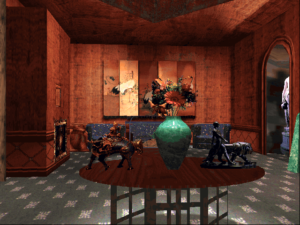
Under a Killing Moon boasted some of the most impressive 3D environments yet seen on a computer. This part of the game was a technological marvel in its own right.
Jones and Conners, for their part, were interested in using 3D not as a test of reflexes but to bring their world to life in a way that third-person graphic adventures, including Access’s own earlier ones, did not. Although Tex Murphy must sometimes use stealth to hide from enemies in the 3D sequences, he never shoots anyone at all within them. Even all these years later, Under a Killing Moon and its eventual sequels still stand out as unusual, noble efforts to use the potential of 3D in the service of something other than what the politicians would soon be labeling “murder simulators.” Jones:
When we sat down to create this experience, we asked ourselves, “If I’m a private investigator, what do I want to do?” Hey, I want to look in drawers! I want to crawl around, look at footprints on the floor, pull things out and examine them! And I want to do that stuff myself. I want to control the action. I don’t want some mouse click to take me on a path over there. Give me all the freedom that you can, then let me interact with that environment.
In talking about “some mouse click to take me on a path over there,” Jones is implicitly comparing his game to The 7th Guest, the industry’s first big CD-ROM-exclusive hit, which appeared in March of 1993 and paved the way for Under a Killing Moon by unleashing at last the long-anticipated wave of CD-ROM uptake among consumers. And indeed, at a casual glance The 7th Guest seems like a very similar game to Access’s effort: it too blends 3D environments with full-motion-video clips of real actors, and it too is among the earliest games to require an SVGA graphics card.
Look closer, however, and the differences become stark. The 7th Guest uses a node-based movement system; thus Jones’s disparaging reference above. Your movements from node to node inside the haunted mansion where it takes place are presented via pre-rendered 3D animations. Under a Killing Moon, on the other hand, does its rendering on the fly, giving you a glorious free-scrolling environment to roam as you will — crouching, bending, looking on top of things and under things and inside things. It’s an extraordinary achievement, especially given that it’s almost entirely the work of a single programmer, a longtime Access stalwart named Bruce Johnson. In order to get the speed he needed from the hardware available at the time, he had to write it in pure assembly language — an approach which even as storied a programmer as id’s John Carmack had abandoned by that point as just too much trouble. Access Software is seldom mentioned as a 3D pioneer on the level of Looking Glass Technologies (née Blue Sky Productions) and id Software, but perhaps that’s unjust. Their reputation in this field may have been ironically undermined by their other ambitions — for, instead of being content merely to redefine the state of the art in 3D environments, Jones and Conners used 3D as just one component in their game.
The other side of the equation is, as mentioned, full-motion video, which is used for cut scenes that advance the story along and for your menu-driven conversations with others. Like virtually all such productions from the 1990s, Under a Killing Moon leaves much to be desired by the cineastes among us. Even the most experienced professional actors would surely have struggled to deliver good, natural-feeling performances when forced to ply their trade in front of a plain blue screen, waving around clumsy props that would later be painted over by Access’s artists, being directed by Jones and Conners themselves, who, clever and creative though they were, had never been to film school. But then, much of the cast of Under a Killing Moon are not professional actors, and, believe me, it shows.
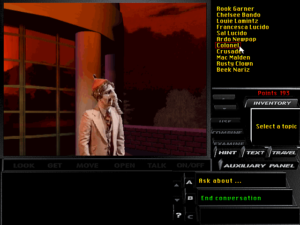
A conversation with Beek Nariz, who was played by Doug Vandegrift. He “nose” a lot about goings-on in the criminal underworld, and what he doesn’t know he can sniff out.
Whether that quality of rank amateurishness is ultimately to the game’s detriment, however, is a different question. Under a Killing Moon‘s secret sauce, which makes it work even where it really ought not to, is its sheer likability. Chris Jones deadpans his way through the role of Tex in a fashion that will never win him any acting awards, but it does win the viewer’s sympathy. The same applies to virtually every other amateur who appears onscreen, often in ludicrous homemade prosthesis and makeup appropriate for their mutant personae. Whether childhood friends of Jones and Vandegrift or people who just happened to work at Access, they’re clearly having a great deal of fun with their roles, and they clearly want us to have fun watching too.
Deep into production, Jones learned during a chance conversation with his brother that the latter knew a Hollywood talent agent who was in Salt Lake City casting for a movie. Doug Vandegrift:
She said, “If you guys want to hire Hollywood actors, I can arrange that.” But we really didn’t take it seriously until she called up one day and said, “I’ve got Margot Kidder. She’s got to go to the airport in three hours, but right now she’s sitting in Salt Lake City doing nothing. If you’d like for her to come, you can have her for three hours.” Aaron quickly wrote something, she showed up, and had great fun doing it.
We thought, well, if we can get her, maybe we can get somebody else. Before we knew it, Brian Keith came in for a day.
In an amusing reminder of Access’s essential Mormon-ness, Brian Keith, whose gruff persona in television shows like Hardcastle and McCormick apparently wasn’t affected, became in Aaron Conners’s recollection the first person ever to “drop an F-bomb” in the office. This must mark some sort of record; normally the F-bombs flow like soda inside a games studio…
Russell Means, a supporting player in the recent movie The Last of the Mohicans, also joined the cast. These “stars” who came on such short notice and left just as quickly stand out from the amateur thespians considerably less than one might expect. Like so many Hollywood actors who slummed it in CD-ROM during the heyday of the full-motion-video craze, they used Under a Killing Moon as an opportunity to chew up some scenery and have a little fun playing out-sized versions of the roles for which they were best known. “I don’t think she was really quite sure of what we were doing,” says Chris Jones about Margot Kidder. “Her reference point was Nintendo and Sega.”
Undoubtedly Access’s biggest coup was the casting of James Earl Jones, the iconic voice of Darth Vader himself, as narrator. It was really on a lark that they even rang up his agent — and sure enough, the initial response was, to say the least, not positive: “No way, no way will we do this, no way.” In the end, though, James Earl Jones did agree to do the job, and for a fraction of his normal rate at that, because his son had played and loved Access’s earlier adventure games and had been following the progress on this one closely: “Dad, you’ve got to do this!” Consider: LucasArts had just started making Star Wars games at the time, and yet with all their connections were forced to settle for a soundalike in the role of their Darth Vader. But here he was, performing for Access. Under a Killing Moon truly was a charmed project.
But if its makers were lucky, they earned their luck by doing everything they could to make sure that everyone who played it got more fun than frustration out of the experience. For example, it’s impossible to lock yourself out of victory without knowing it. Another telling sign that this game is on its player’s side is its interactive hint system, which you’re free to use as much or as little as you want. There’s even an “easy play” mode that lets you skip the puzzles completely and just explore the story. The designers plainly aren’t entirely comfortable with the idea — “you’ll enjoy a new level of entertainment” if you only use easy mode to “become familiar with the controls” and then move on to the real thing, says the manual — but, hey, if you really want to play that way, that too ought to be your right.
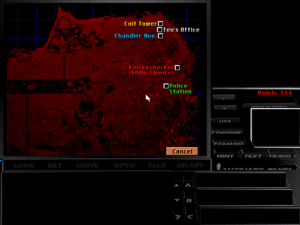
The travel interface, to which locations are added as time goes on and you learn about them. Under a Killing Moon uses plot time instead of clock time: time advances only in response to you making progress in your investigations. This technique, which had been pioneered by Infocom in Ballyhoo and used to good effect in the first Gabriel Knight adventure in the year before this game was released, was by this point becoming a staple of the adventure genre. And small wonder: it allows for a dynamic, unfolding plot without letting said plot run away without the player. What it sacrifices in realism, in other words, it recoups in practicality and mercy.
Yet another innovation for the player’s sake — perhaps the most enduring of all — is found in the conversation system. Menu-based conversations had been a staple of graphic adventures for quite some time, but Jones and Conners noted how awkward it felt to click on a line of dialog for Tex and then hear him parrot the very same line back. Aaron Conners:
Almost every game at the time would show the full line of dialog. We said, “This is so tedious.” A lot of the wordy games, including some of the best ones, like Monkey Island — fantastic, wonderful humor… but even with that I got tired of reading it and then hearing it. I had to come up with some other way to do it.
So, they implemented a mood-based conversation menu: instead of seeing exactly what Tex will say, you see options like (in the case of a potential love interest) “subtle innuendo,” “lovesick puppy,” and “charmingly curious.” This way, you still feel like you’re directing the course of the conversation, but some element of surprise is preserved. This system went on to influence no less a gaming blockbuster than the Mass Effect franchise, whose development teams included some avowed fans of the Tex Murphy games.
There’s an honesty about Under a Killing Moon, a commitment to its plot and premise that is lacking from most contemporary interactive movies. Again, a comparison to The 7th Guest is unavoidable. The earlier game is the poster child for puzzles that exist purely to give the player something to do, that have no connection whatsoever to a game’s fiction. But, in the words of Chris Jones, “there are no 7th Guest-type things” in Under a Killing Moon: “You know, ‘Here’s a puzzle to solve so you can move to the next room. Move these little marbles around here or whatever. None of that. In Under a Killing Moon, everything is interrelated.” The things you do in the game are mostly the things that a real private detective might be expected to do in order to solve a crime: interviewing people, searching premises for clues, piecing together the evidence to come another step toward the solution. Even those that are thoroughly goofy and would certainly never appear in a detective movie still bear directly on the case you’re trying to solve. And even those puzzles that might initially seem like roadblocks for the sake of roadblocks — like Tex’s urgent need for a new fax machine to replace his broken one — turn out to be useful as background, in this case by establishing just how down and out our hero actually is. At the time of its release, Under a Killing Moon was simply the best, most honest interactive implementation of a mystery — arguably the fictional genre most naturally amenable to becoming an adventure game — to appear since The Lost Files of Sherlock Holmes.
By the time it was released just in time for the Christmas of 1994, Under a Killing Moon had taken two years and some $5 million to create, making it one of the two most expensive computer games ever made to that point. It was also one of the two biggest games yet made in terms of sheer number of bits: it grew from one CD to two to three to four over the course of its development. In both departments, it was equaled only by the near-simultaneously released Wing Commander III from Origin Systems, another, very different take on the full-motion-video interactive movie. How strange to think that just a year or two earlier developers had been fretting over how they would ever manage to fill up a single CD! Not content with blowing past the one-gigabyte barrier in 1994, these two games had already exceeded two gigabytes in size. It was as frenzied a period of technological change as gaming has ever known.
Under a Killing Moon was greeted with a brutal review in Computer Gaming World, courtesy of Charles Ardai, that magazine’s resident curmudgeon as well as my favorite gaming scribe of the 1990s. His take-down is odd not least because he had previously given Countdown and Martian Memorandum fairly glowing reviews. Nevertheless, his review of Under a Killing Moon makes some very valid points, so much so that I want to quote from it here as the flip-side to my positive take on the game.
With the plot about the cult and the crusade for genetic purity, [the developers] appear to be trying to tell a serious story, with serious threats and grim implications. Yet every time the story threatens to go in an interesting direction, they cut it off at the knees by throwing in lame, inappropriate jokes and cheap slapstick, such as scenes that involve Tex falling over in his chair or walking into walls or getting captured by villains who do Three Stooges-style eye-poking shtick.
This undisciplined willingness to sacrifice the story in order to stick gags in where they don’t belong is typical of amateur writers, and it is deeply unsatisfying. Jones and Conners seem to be hoping that they can make a single game be both a serious thriller and a goofy comedy, both Chinatown and Dead Men Don’t Wear Plaid, and it just doesn’t work.
Ardai isn’t precisely wrong about any of this; the game’s tone really is all over the map, in that way all too typical of adventure-game writers — and, yes, amateur writers of all stripes — who lack the courage of their convictions, and seek to head off criticism of their productions’ manifest weaknesses by suddenly playing them for laughs. Normally, this sort of thing irritates me as badly as it does Ardai.
In this case, however, it doesn’t; I recognize the game’s disjointedness, not only in terms of its fiction but in the disparate gallery of techniques and interfaces it uses to present its story, but I’m just not that bothered by it. For me, Under a Killing Moon is a shaggy beast for sure, but also a thoroughly lovable one. When I ask myself why this should be, I find myself tempted to fall back on those vague platitudes that are the hallmark of the amateur critic: that the game has “soul”; that it is, God help us, “greater than the sum of its parts.”
Since that will obviously never do, let me note that it has at least three saving graces. One is a certain cultural sophistication which peeks through the game’s pastiche, telling us that its creators were a bit older than the norm and had a taste for things beyond Dungeons & Dragons and Star Wars: the street where Tex Murphy lives is called Chandler Avenue after the beloved crime novelist; the central Mcguffin of the game is a bird statuette, a nod to The Maltese Falcon. Another is its bold spirit of innovation, its willingness to try not just one new thing but a whole pile of them, despite working in the terminally conservative ludic genre of the adventure game, which usually departs from the tried and true only with the utmost reluctance. And a third — probably the most important of all — is one that I’ve already mentioned: its exuberant likability. Just being nice — being the kind of person that other people enjoy being around — will get you a surprisingly long way in life. If Under a Killing Moon is any evidence, the same is true in games.
Here, then, is the ultimate difference maker between Under a Killing Moon and a game like The 7th Guest: the former is generous to its player while the latter is stingy. Although Under a Killing Moon gleefully employs every piece of trendy technology its developers can get their hands on, it’s all done for the purpose of making a fun game of the sort that said developers themselves would like to play; it’s not done merely to make a statement about the alleged multimedia zeitgeist, much less to rake in beaucoups of cash. The money, one senses, was always secondary when it came to Tex Murphy. (Why else invest millions into risky interactive movies at all instead of wallowing contently in the ocean of guaranteed profit from the Links franchise?)
There’s an open-hearted joy about Under a Killing Moon that makes up for a multitude of acting and even writing sins. It’s still bursting with that excitement which Jones and Vandegrift felt as kids — “We’re making a movie!” It’s just that now it’s an interactive movie. Under a Killing Moon is a wonderful tonic in a cynical world. If that sounds odd, given that the game takes place in such a dystopian setting, it serves only to point out how special its personality really is. The game tells us that the best parts of us, the things we sometimes call our basic humanity, will always survive. Chris Jones:
Okay, this world’s worn-out and ugly and partially destroyed, but people are people. People still have their sense of humor. People still have an outlook they can hang onto. Even if the world’s going to hell, it’s the only world they’ve got. To be dragged down in the mud attitude-wise or [imagine] things never improving… well, maybe they will never improve, but there’s got to be some hope that they will.
It strikes me that the most under-discussed aspect of Under a Killing Moon, as well as quite possibly our key to understanding all this, is the Mormon community from which it sprang. There are all sorts of reasons for the silence on the subject, starting with many would-be game historians’ apparent belief that individual games can be understood without taking account of the real-world beliefs and biases that went into them, passing through the way that the people who made this particular game studiously avoid the subject, ending with how loaded any discussion at all of religion has become in our societies. Not everyone who worked on Under a Killing Moon was Mormon — even a community like Bountiful is “only” 75 percent Mormon, with a substantial Catholic minority among its other believers and non-believers — and the game never, ever proselytizes; it wants to entertain you, not convert you. Nevertheless, it has a distinct Mormon sensibility, and is all the better for it.
There is, I think, a tendency among many non-believers who lack experience with religious communities to imagine them as unduly grim milieus, where everyone marches in lockstep as Soldiers of God, where there is no room for warmth or humor or whimsy, no space for secular culture of any stripe. But, as Under a Killing Moon amply demonstrates, that’s not always or even usually the case at all.
Of course, like any dogmatic religion, Mormonism comes complete with a set of Lines That Shall Not Be Crossed, whose nature I won’t belabor here. Yet it’s more forward-looking than many religions, with surprisingly little aversion to modernity within its strict lines of demarcation. Based on my own limited experience, this orientation translates into a genuine desire to see the faithful live up to their individual talents here in the world. You can see this quality manifested in Under a Killing Moon, along with much else that will strike a chord of recognition with anyone who has ever lived among or around Mormons. I recently discussed the subject with Jeff Roberts of RAD Game Tools, a longtime friend of this site who did some contract work on the game’s video-compression system:
Yeah, I joke about how LDS the humor seems to me. It’s super chaste, awkward humor. Very dad-joke humor. I grew up in Utah as a non-Mormon, so I sense that feeling immediately (Book of Mormon nails that perfectly). But yeah, any clips of Access games immediately trigger a “whoa…” in me to this day. They did a “comical” golf game a few years later that really pegs the Mormon meter for me: “Extreme” something… yikes, so bad.
I remember a funny story about Bruce [Johnson] being a henchman that has to grab a girl that was being abducted, but Bruce was embarrassed and it kept filming badly, which led to the actor playing the girl finally just saying, “Look, can you just grab me, so I can go home?”
Under a Killing Moon is the videogame equivalent of Mitt Romney, the whitest man in the world, marching gawkily along with a Black Lives Matter protest, just because, gosh darn it — and Mitt Romney would actually say, “Gosh, darn it,” in 2020 — it’s the right thing to do. As far as the game is concerned, the Right Thing is to try its own earnest, gawky best to give its players the best time ever.
Fortunately for Access, most gamers hewed more to my verdict on Under a Killing Moon than to Charles Ardai’s. In spite of a coveted segment on the television show Entertainment Tonight, the game didn’t become a breakaway mainstream icon of the early CD-ROM era like The 7th Guest or Myst. But it did do well among the slowly expanding audience of core gamers, enough to earn back its development budget and justify another Tex Murphy game. So, one of the most likable series in the history of adventure gaming got to continue on its goofy way, and thus will be making another appearance as part of these histories before all is said and done. In the meantime, give the game a shot if you haven’t already. You might be surprised at how much wholesome fun a post-apocalyptic dystopia can be.
(Sources: the book Under a Killing Moon: The Official Strategy Guide by Rick Barba; Computer Gaming World of January 1990, January 1991, January 1992, August 1994, and January 1995; Electronic Entertainment of November 1994 and January 1995; Commodore Magazine of July 1987 and August 1987; Provo Daily Herald of January 25 1989, August 1 1990, August 21 1990, June 23 1992, September 19 1993, and October 8 1994; various Bountiful city newsletters. Video sources include the original film of Plan Ten from Outer Space, with commentary from the makers; the documentary The Making of Tex Murphy; and Chris Jones, Aaron Conners, and Mat Van Rhoon on the Back Seat Designers podcast. And I owe a huge thank you to Jeff Roberts for sharing his impressions of working with Access Software.
Under a Killing Moon is available for digital purchase on GOG.com.)
